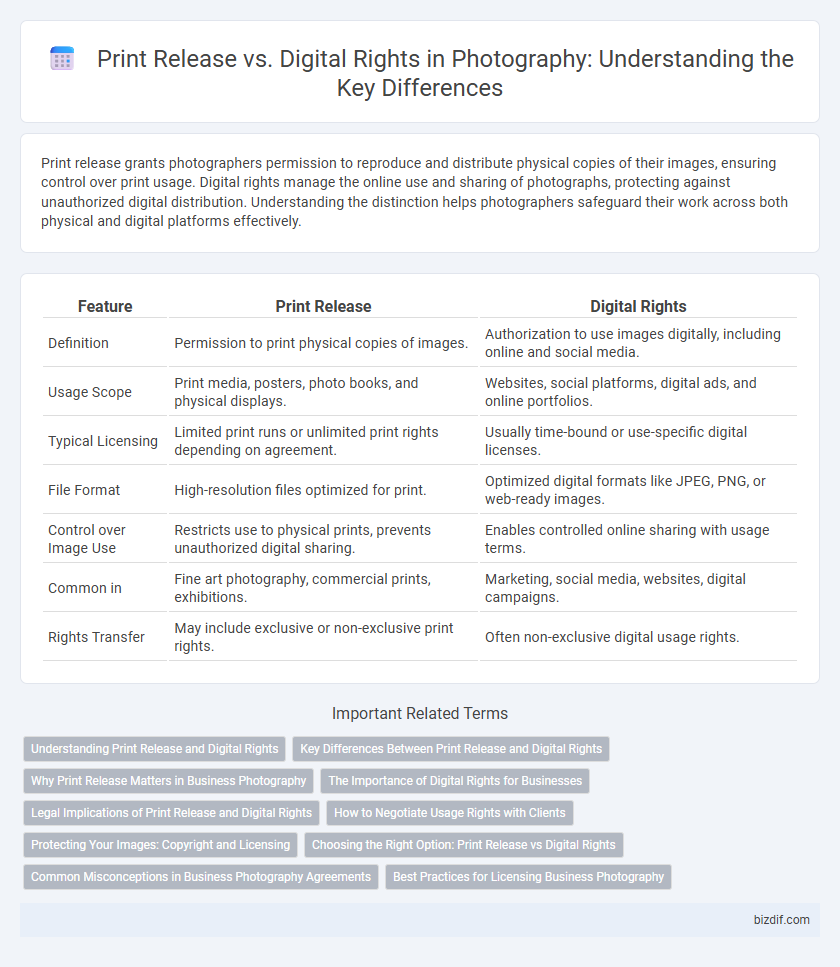Print release grants photographers permission to reproduce and distribute physical copies of their images, ensuring control over print usage. Digital rights manage the online use and sharing of photographs, protecting against unauthorized digital distribution. Understanding the distinction helps photographers safeguard their work across both physical and digital platforms effectively.
Table of Comparison
| Feature | Print Release | Digital Rights |
|---|---|---|
| Definition | Permission to print physical copies of images. | Authorization to use images digitally, including online and social media. |
| Usage Scope | Print media, posters, photo books, and physical displays. | Websites, social platforms, digital ads, and online portfolios. |
| Typical Licensing | Limited print runs or unlimited print rights depending on agreement. | Usually time-bound or use-specific digital licenses. |
| File Format | High-resolution files optimized for print. | Optimized digital formats like JPEG, PNG, or web-ready images. |
| Control over Image Use | Restricts use to physical prints, prevents unauthorized digital sharing. | Enables controlled online sharing with usage terms. |
| Common in | Fine art photography, commercial prints, exhibitions. | Marketing, social media, websites, digital campaigns. |
| Rights Transfer | May include exclusive or non-exclusive print rights. | Often non-exclusive digital usage rights. |
Understanding Print Release and Digital Rights
Print release grants photographers permission to reproduce and distribute physical copies of their images, often specifying the allowable quantities and formats. Digital rights encompass the usage, distribution, and modification of images in electronic formats, typically controlled through licensing agreements that dictate online sharing, editing permissions, and commercial use. Clear understanding of both print release and digital rights ensures protection of intellectual property while enabling appropriate exploitation of photographic works across various media.
Key Differences Between Print Release and Digital Rights
Print release grants permission to reproduce and distribute physical copies of photographs, primarily for printing purposes, while digital rights control the usage, distribution, and modification of images in digital formats across online platforms. Print release often limits usage to specific print runs or materials, whereas digital rights encompass broader control over electronic display, copying, and sharing. Understanding these key differences ensures photographers maintain proper ownership and revenue streams across various media channels.
Why Print Release Matters in Business Photography
Print release in business photography grants clients explicit permission to reproduce images in physical formats, safeguarding photographers' intellectual property while enabling marketing materials and product displays. Unlike digital rights, which govern online and electronic use, print releases clarify usage limitations, preventing unauthorized mass production and ensuring proper attribution. Clear print release agreements enhance trust, protect revenue streams, and establish professional standards essential for business growth.
The Importance of Digital Rights for Businesses
Digital rights enable businesses to control the usage, distribution, and reproduction of their photographic content, ensuring protection against unauthorized exploitation. Unlike print release, which typically covers physical copies, digital rights focus on online and electronic usage, crucial for maintaining brand integrity and preventing revenue loss. Proper management of digital rights supports licensing agreements and maximizes the commercial value of photographic assets in digital marketing campaigns.
Legal Implications of Print Release and Digital Rights
Print release grants clients permission to produce physical copies of photographs, but it does not automatically transfer copyright ownership or digital usage rights. Digital rights define how images can be used online or in electronic formats, often requiring explicit agreements to prevent unauthorized distribution. Understanding the legal implications of both ensures photographers maintain control over reproduction while clients receive clear usage guidelines, reducing the risk of copyright infringement.
How to Negotiate Usage Rights with Clients
Negotiating usage rights with clients requires clear communication about print release and digital rights to establish how images can be used, distributed, and sold. Defining specific terms for print releases, including permitted print sizes and quantities, alongside digital rights covering online display and social media sharing, helps prevent future disputes. Photographers should include detailed clauses in contracts specifying usage scope, duration, and any additional fees for extended rights to protect their creative work and ensure fair compensation.
Protecting Your Images: Copyright and Licensing
Protecting your images involves understanding the differences between print release and digital rights. A print release grants clients permission to print your photographs, usually in limited quantities and sizes, while digital rights define how your images can be used, shared, or altered online and across digital platforms. Securing proper copyright and licensing agreements ensures photographers maintain control over image usage, preventing unauthorized distribution and preserving the value of their work.
Choosing the Right Option: Print Release vs Digital Rights
Choosing between a print release and digital rights depends on how the photographs will be used and distributed. Print releases grant permission for physical reproductions, such as prints or posters, often with specific limitations on quantity and size, while digital rights encompass usage for electronic formats like websites, social media, and digital marketing. Evaluating the intended audience, distribution channels, and control over image usage helps photographers or clients select the option that maximizes exposure while protecting copyright and monetization opportunities.
Common Misconceptions in Business Photography Agreements
Print releases often lead to confusion as many believe they grant full usage rights, whereas they typically allow only limited print reproduction under specific conditions. Digital rights encompass broader usage, including online distribution and digital marketing, but business photography agreements frequently lack clarity in differentiating these scopes. Misunderstanding these distinctions can result in unauthorized use or costly legal disputes over image licensing and intellectual property.
Best Practices for Licensing Business Photography
Print release grants clients permission to produce physical copies of business photography, defining clear terms for print usage and distribution rights. Digital rights cover online display, modification, and sharing, requiring explicit licensing to protect against unauthorized reproduction and maintain control over image integrity. Combining both releases in licensing agreements ensures comprehensive protection and clarity, safeguarding photographers' legal and financial interests.
Print Release vs Digital Rights Infographic

 bizdif.com
bizdif.com